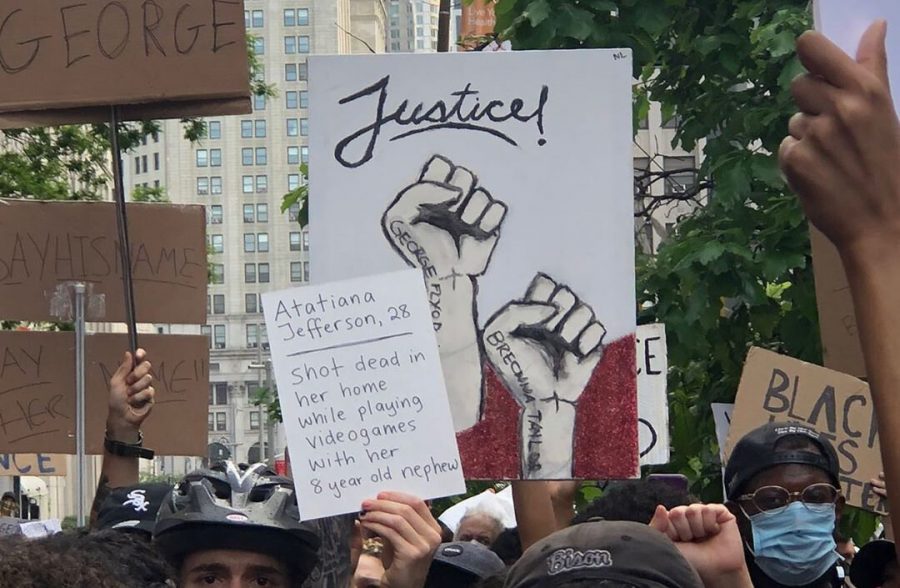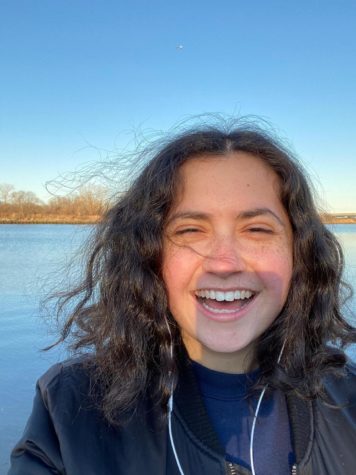Baruch students protest for change across the city in the wake of the George Floyd killing
June 16, 2020
On a hot June day, Baruch College student Gabriela Lopez-Castillo walked through the streets of Manhattan, surrounded by hundreds upon hundreds of other New Yorkers, all marching for the same goal: to bring an end to police brutality and racial discrimination toward black Americans.
As she marched, she looked up at a handmade sign that listed the names of tons of black citizens who were murdered at the hands of police officers — generally white officers.
There were so many names on the list that she didn’t recognize, so many lives taken that she had never heard about, that she felt compelled to stop in the middle of the street to read them before the sign’s owner got out of view.
“It broke my heart reading them, knowing that those names are just the tip of the iceberg,” Lopez-Castillo said. “There are so many people that we do not know of, people that lost their lives.”
In the wake of the George Floyd killing in Minneapolis on May 25, protests and riots have broken out across the world, with protests occurring in all 50 states and on six continents.
New York was home to protests throughout the state, but primarily in New York City, where the boroughs of Manhattan and Brooklyn saw the most protests.
Lopez-Castillo was not the only CUNY student who participated in these events. It is impossible to estimate the number of city university students, staff members and faculty that were present, but it is a fact that the issues being discussed as a result of the protests impact many CUNY community members.
As a whole, 25.2% of students enrolled in all CUNY schools as of 2019 — that’s including all of the senior colleges, community colleges, graduate schools and honors college — are black. Another 30.2% are Hispanic or Latino.
The next highest demographic at CUNY schools is white, with about 23.1% of all CUNY students identifying with that race, followed by Asian Americans and Pacific Islanders at 21.1%, and American Indians and Alaskan Natives at 0.3%.
Thus, the issues of racial discrimination, police brutality and racism are very much play throughout CUNY campuses, and with some of the university’s students being deeply invested in politics and social justice, these issues have incited some students to attend the protests.
This was the case of Lopez-Castillo, who told The Ticker in an email interview that she had never protested before the protests for Floyd.
“George Floyd, along with so many others, lost their lives, at the hands of not just officers who failed them, but a system that could not do better,” the former Marxe School of Public and International Affairs student said. “The system is inherently broken, and I felt like retweeting, sharing, speaking to my peers was not enough. Tangible changes, long lasting systemic changes cannot happen on a tweet alone. If racism could be solved with a single Instagram post, then we would not be in this situation. I needed to do more.”
This seems to be a sentiment shared among CUNY protestors, such as Kevin Zhagui, who studied corporate communications at Baruch.
“I made up my mind as soon as they announced it,” he told The Ticker in an email interview. “Yes, corona virus is out there but I honestly told myself if I were to die doing the right thing then this would be it. For a chance to be a part of change and really learn more about what the message was about. What it took to have a voice for change.”
As a non-black person of color himself, Zhagui said that he stands by his black neighbors in the fight for racial equity, in addition to justice for the individual families of police brutality victims.
“The black community needs reparations,” he said. “In this racial system black people have lost so many opportunities to engage in the purchase of property and to raise their level of wealth. As a Latino American, I know that American history is dark, unjust, unfair and bias against blacks and other minorities. This reaction from the black community has been long overdue and I hope change comes.”
Other CUNY students had different things to say about the reasons behind attending the protests.
For Joel Desouve, a student at Baruch’s graduate school who attended the protests in Brooklyn and Manhattan ands who spoke to The Ticker over the phone, the existence of racism is the basis for the protests, for the #BlackLivesMatter movement and for Floyd’s murder.
“I don’t understand why we have racism,” he said. “I don’t understand that at all. So, it doesn’t make sense to me for people to be racist . . . for people to see other races like less than any other race.”
He also touched on CUNY’s performance during the movement and its relationship to its black students.
“CUNY has to do more, New York City has to do more,” he said. “Especially that CUNY keeps raising its fees. Now, I think that that the Board of Trustees is about to put like $320 more toward tuition, so they keep raising and what happens is that you will have those people from the black community — black and brown people — they will not be able to afford it, because when you keep raising the price of CUNY, they will drop out, because they will have to decide between paying for college, paying for rent, paying for the Metro . . . So, I believe CUNY can do more, Baruch especially can do more.”
Another Baruch protester, Tiana Ruiz, said that she also feels there is progress to be made within both CUNY and Baruch on the topics of race and discrimination.
“Being in CUNY has shown me that even attending one of the most diverse campuses in America doesn’t automatically mean racism doesn’t exist,” she told The Ticker in an email interview. “I’ll never forget in 2017 when a white female Baruch student made a snapchat mocking the ‘I Can’t Breathe’ slogan.”
“I see a lot of Baruch students who I personally know not speaking on this issue which makes me come to believe no matter the amount of diversity around you, people will choose to ignore and keep their own beliefs,” she went on to say. “It’s a really big shame.”
CUNY’s diverse makeup isn’t the only fact worth bringing up about the university, Lopez-Castillo pointed out.
“As a CUNY student, I am not a stranger to our students raising their voices against the powers that be, and it is amazing that we are able to do so,” she noted. “CUNY thrives (though not as much as it could be because of obscene slashes to several schools’ budgets throughout the system, while the NYPD receives billions.), not just because of what it offers, but because of the students that are welcomed through their doors. These students come from all walks of life, communities, ethnicities and races, including the black community.”
For her, it goes beyond that.
“As a CUNY student, I want to march for a better system overall for my fellow students,” Lopez-Castillo continued. “In an ideal world, a college student should only be worrying about finals, and passing that one hard class. But in this world, our justice system has created a society in which our black students have to worry about their lives being ended at the hands of an officer that should have protected them.”
“I do not want this world for any student, but most especially, our black students,” she added. “I march with the Black Lives Matter for them. For every member of our black community.”








